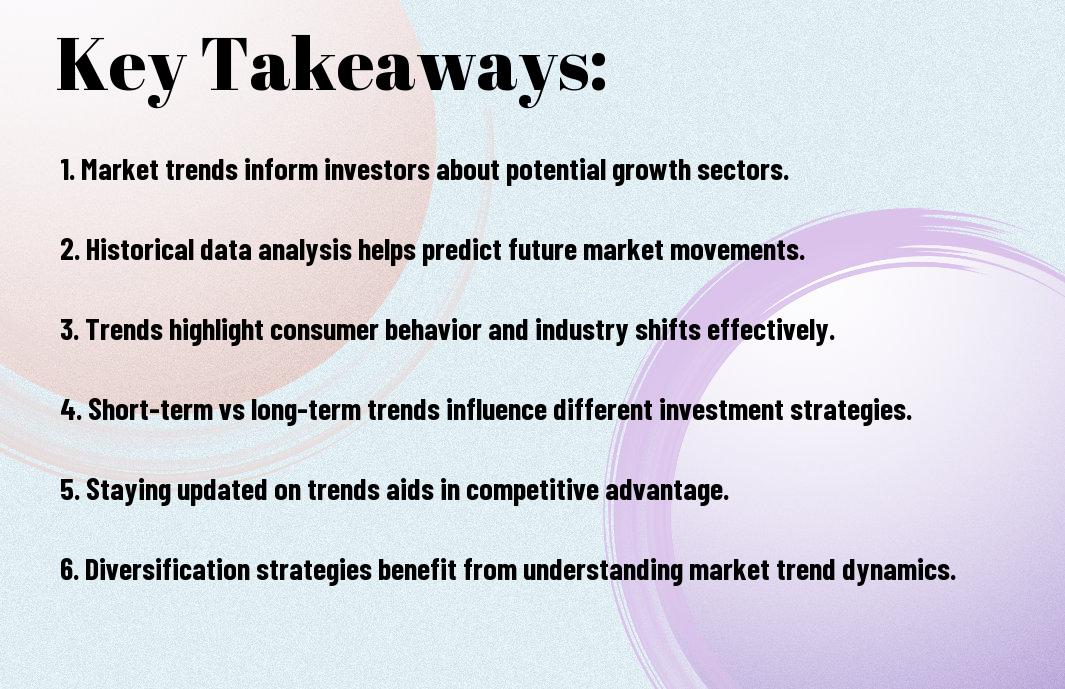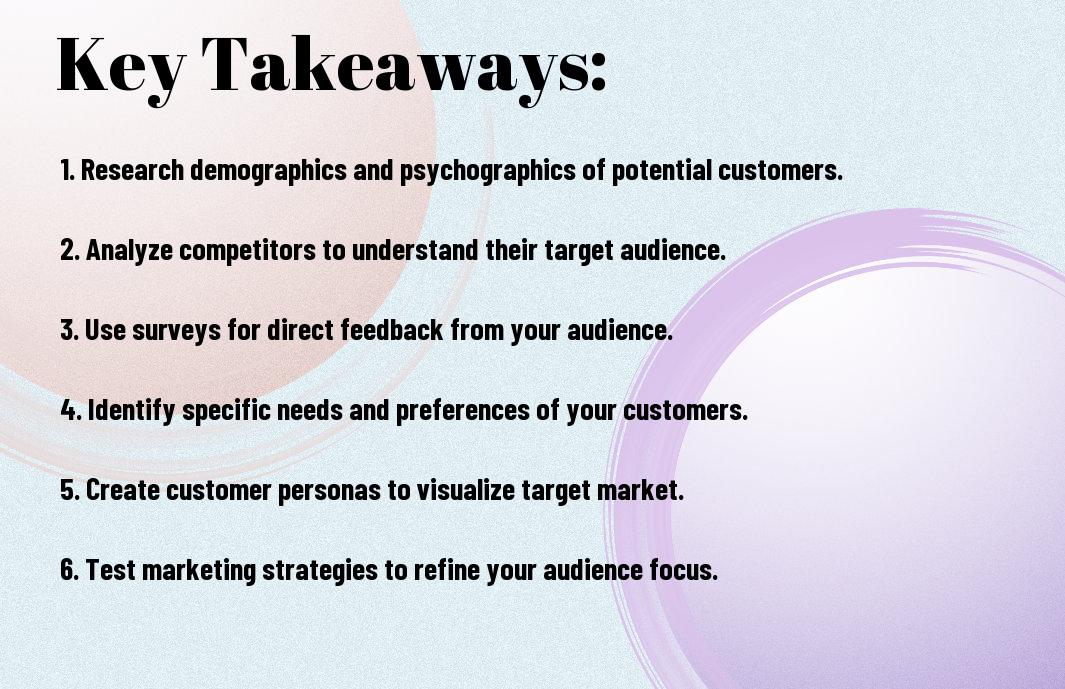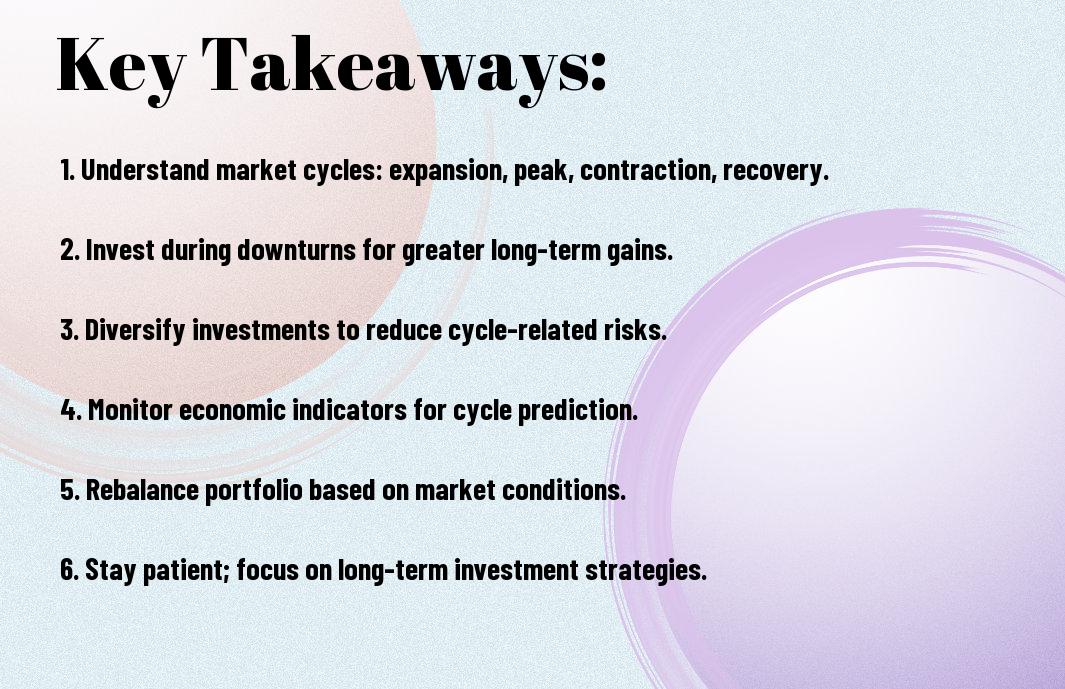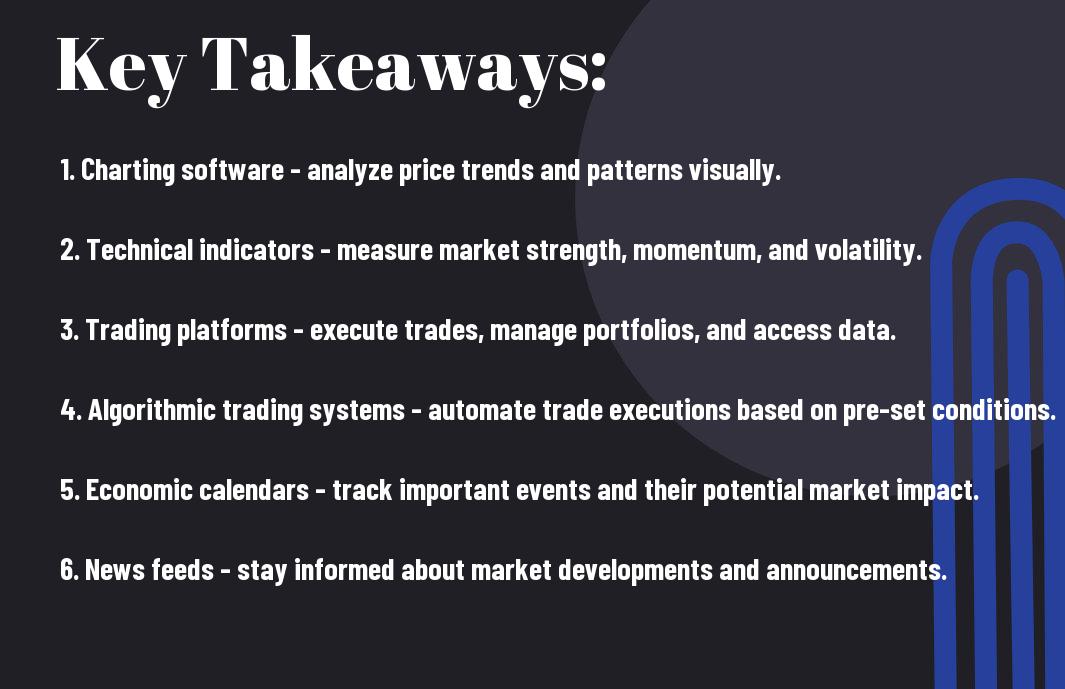Over the years, understanding market trends has become an necessary component of making informed investment decisions. By analyzing patterns, shifts, and movements within the market, you can better gauge where to allocate your resources for maximum potential return. This blog post will explore how you can effectively interpret market trends to enhance your investment strategies and navigate the complexities of the financial landscape with confidence.
Key Takeaways:
- Market Analysis: Understanding current market trends is crucial for making informed investment decisions.
- Risk Management: Awareness of market trends helps in assessing potential risks and rewards associated with different investment options.
- Diversification Strategy: Identifying trends can guide investors in diversifying their portfolios to mitigate risks during market fluctuations.
- Timing the Market: Awareness of trends may assist investors in determining optimal entry and exit points for their investments.
- Long-term vs Short-term: Trends can influence whether to pursue long-term investments or short-term trading strategies based on market momentum.

Understanding Market Trends
The investment landscape is continuously influenced by market trends. Recognizing and understanding these trends can empower you to make informed investment decisions, paving the way for potential growth and success in your portfolio. Whether they signal rising sectors or impending downturns, being attuned to these fluctuations is imperative for every investor.
Defining Market Trends
At its core, a market trend represents the general direction in which an asset or market is moving over a particular period. By analyzing these patterns, you can identify whether a market is bullish (rising), bearish (falling), or stagnant. This understanding lays the groundwork for strategic investment decisions tailored to meet your financial goals.
Types of Market Trends
One can categorize market trends into three primary types: downward (bear), upward (bull), and sideways. Each type can influence your buying or selling strategies, depending on market conditions. Here are the key types:
| Trend Type | Description |
|---|---|
| Uptrend | Consistent price increases over time. |
| Downtrend | Consistent price declines over time. |
| Sideways Trend | Little to no price movement in either direction. |
| Short-term Trends | Trends lasting a few days to weeks. |
| Long-term Trends | Trends extending over several months or years. |
- Market trends can impact your investment strategies significantly.
- Monitoring trends helps you identify potential opportunities and risks.
- Thou must stay updated on market conditions to act promptly.
Indeed, understanding different market trends is vital to navigating your investment journey effectively. Each type can provide insights into potential future movements, allowing you to adapt your strategies accordingly. Expanding your knowledge in this area helps you make more informed decisions.
| Trend Type | Potential Impacts |
|---|---|
| Uptrend | Encourages buying and investment expansion. |
| Downtrend | May necessitate reevaluation of holdings. |
| Sideways Trend | Encourages wait-and-see approach. |
| Short-term Trends | Can lead to quick profits but higher risk. |
| Long-term Trends | Focus on sustained growth and stability. |
- Identifying trends can help you anticipate market movements.
- Each trend type can steer your investment decisions.
- Thou should analyze the context of trends before acting.
The Importance of Market Trends in Investment Strategy
Clearly, incorporating market trends into your investment strategy is important for maximizing returns and minimizing losses. Understanding these trends helps you align your investments with shifting consumer preferences, economic indicators, and technological advancements, allowing you to make informed decisions that enhance your portfolio’s performance.
Identifying Opportunities
By analyzing market trends, you can uncover valuable investment opportunities that may otherwise go unnoticed. Staying attuned to changes in consumer behavior and emerging industries enables you to identify sectors poised for growth, allowing you to capitalize on potential gains before they materialize.
Risk Management through Market Trends
Importance of understanding market trends extends beyond identifying opportunities; it also plays a pivotal role in risk management. By closely monitoring market fluctuations, you can make proactive adjustments to your investment strategy, reducing exposure to volatile assets and safeguarding your portfolio against potential downturns.
Also, recognizing patterns in market trends helps you anticipate fluctuations and mitigate potential losses. By understanding historical trends and their influence on current market conditions, you can build a diversified portfolio that balances risk. Establishing stop-loss orders and reallocating assets based on market signals further supports your overall risk management strategy, ensuring you’re more resilient in a dynamic investment landscape.

Tools and Techniques for Analyzing Market Trends
For successful investment decisions, you will benefit from using a range of tools and techniques to analyze market trends. Utilizing resources such as Market sentiment and firm investment decision-making can provide insight into how market conditions affect investor behavior and economic health. Techniques include both technical and fundamental analysis, each serving to enhance your understanding of market movements and potential future performance.
Technical Analysis
Below you will find that technical analysis involves examining historical price data and trading volume to identify patterns that may predict future price movements. By utilizing charts and indicators, you can spot trends, reversals, and momentum, enabling you to make informed decisions based on market behavior.
Fundamental Analysis
Among the methodologies available, fundamental analysis focuses on evaluating a company’s intrinsic value by examining financial statements, industry conditions, and economic factors. This approach allows you to assess the overall health and performance potential of an asset, thereby guiding your investment strategy effectively.
A key aspect of fundamental analysis is understanding the economic and financial variables influencing a company’s performance. By analyzing revenue growth, profit margins, and market trends, you can gauge the sustainability of a business and the likelihood of achieving favorable returns on your investment. Engaging in this level of analysis helps you make data-driven and strategic decisions in your investment portfolio.
Case Studies: Market Trends Impacting Investment Decisions
Keep in mind that understanding market trends can significantly influence your investment choices. Here are some compelling case studies that illustrate this impact:
- In 2008, the subprime mortgage crisis led to a 50% decline in the S&P 500, prompting many investors to pivot towards safer assets.
- During the COVID-19 pandemic in 2020, technology stocks surged, with companies like Zoom increasing their value by over 400% as remote work became the norm.
- In 2021, the electric vehicle market saw a boom, with Tesla’s market cap skyrocketing to over $800 billion, influencing many investors to explore green energy stocks.
Historical Examples
Studies have shown that historical market trends often precede significant shifts in investment strategy. For instance, the Dot-com bubble of the late 1990s led to a massive influx of capital into tech companies, only for many investors to experience substantial losses during the subsequent crash in 2000. Analyzing such historical examples can offer valuable insights into potential future market directions.
Recent Developments
After the pandemic, the rise of sustainable investing has reshaped your investment landscape, making it imperative to track these developments. Many investors are now prioritizing environmental, social, and governance (ESG) factors when making decisions.
Plus, the adoption of cryptocurrency and blockchain technology has added complexity to market trends. Investors are increasingly drawn to digital assets, with Bitcoin reaching an all-time high of over $64,000 in 2021. Additionally, the growing interest in decentralized finance (DeFi) platforms is influencing how people approach investments. Staying informed about these emerging trends will help you better navigate new opportunities in your investment portfolio.
Behavioral Finance and Market Trends
After analyzing various market trends, it becomes evident that behavioral finance plays a significant role in shaping investment decisions. By understanding how psychological factors influence your actions, you can navigate the complexities of market movements. Emotions, biases, and cognitive errors often impact your perceptions of trends, leading you to make choices driven more by fear or greed than by sound analysis.
Investor Psychology
Between the inherent biases you possess and the collective emotional responses of the market, investor psychology significantly affects how trends are interpreted. Your desire for gains can create a herd mentality, pushing you to follow market movements without thorough evaluation. Recognizing these psychological impacts can empower you to make more informed investment decisions.
Market Sentiment
For you to fully grasp market trends, understanding market sentiment is imperative. This sentiment encapsulates the overall mood of investors, whether they are feeling optimistic or pessimistic, and can drastically influence market movements. By gauging sentiment, you can gain insights into potential trends that may impact your investment strategy.
Sentiment reflects collective investor feelings that drive buying and selling behaviors. Tracking indicators, such as the Fear and Greed Index or market surveys, can help you assess whether the market leans towards bullish or bearish sentiments. By factoring in sentiment, you can adjust your strategies to align with prevailing market mood, potentially enhancing the performance of your investment portfolio.
Future Outlook: Market Trends to Watch
Not every market trend will lead to immediate investment opportunities, but keeping an eye on evolving dynamics can help you make informed decisions. As you look ahead, be vigilant about shifts in consumer behavior, environmental concerns, and economic indicators that could influence your investment strategy. Being proactive in recognizing these trends can set you apart in a competitive landscape.
Emerging Markets
Against the backdrop of traditional economic zones, emerging markets present a wealth of opportunities. With rapidly growing economies and expanding middle classes, these regions can be fertile ground for favorable returns. To stay ahead, you should focus your attention on regions demonstrating solid GDP growth and increasing foreign investment.
Technological Influences
Against a backdrop of rapid innovation, technology continually reshapes the investment landscape. As industries transform, you’ll find significant value in understanding how advancements like artificial intelligence, blockchain, and renewable energy are disrupting traditional models. By aligning your portfolio with tech-driven trends, you can position yourself for future growth.
Markets are becoming increasingly interconnected through technology, which means that you must stay informed about the ways technology affects various sectors. The rise of e-commerce, automation, and digital finance not only changes consumer habits but also creates entirely new investment opportunities. As such, evaluating companies that harness tech effectively can lead to promising returns. Embrace the innovations shaping your investing environment to make strategic decisions that resonate with future market shifts.
Final Words
Considering all points, understanding market trends is important for making informed investment decisions that align with your financial goals. By keeping an eye on economic indicators and fluctuations, you can better navigate the investment landscape and optimize your portfolio’s performance. For a deeper understanding of how global economic trends can influence your investments, check out The Impact of Global Economic Trends on Personal Investments. This insight will empower you to adapt your strategies effectively.
Q: How do market trends impact investment strategies?
A: Market trends serve as key indicators for investors, informing decisions on when to buy or sell assets. By analyzing upward or downward trends, investors can position themselves to capitalize on potential gains or minimize losses. Long-term trends may lead to strategic shifts in asset allocation, while short-term trends often guide tactical trading. Staying attuned to these trends helps investors align their strategies with the broader market environment.
Q: What types of market trends should investors focus on?
A: Investors should consider various types of market trends, including long-term trends, which reflect the overall direction of the market over months or years, and short-term trends, indicating fluctuations over days or weeks. Additionally, sector-specific trends highlight performance within particular industries, which can reveal investment opportunities. Understanding both technical indicators, such as moving averages, and fundamental factors, such as economic reports, can provide a comprehensive view of market trends.
Q: How can investors effectively analyze market trends?
A: To analyze market trends effectively, investors can utilize a combination of technical analysis tools, such as charts and indicators, and fundamental analysis, which involves studying economic data and company performance. Monitoring news related to economic developments, policy changes, and global events is also important. By synthesizing these insights, investors can identify emerging trends and make informed decisions regarding their investment portfolios.










